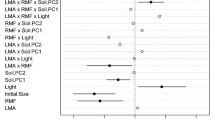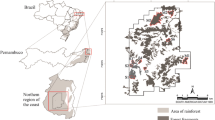Abstract
There are abundant opportunities for progress in the following fields: (1) maintenance of species richness, particularly in characterizing the factors which chiefly control the population sizes of co-existing species and in determining the extent to which sparse species in any given community have an appreciable impact on each other; (2) the relative importance of shoot and root. mediated interference between plants, and the involvement of various mechanisms of root mediated interference, in the control of relative abundance and primary and secondary dominance and in the exclusion of species from particular communities; and (3) leaf form and function, particularly in understanding the evolution of maximum rates of net assimilation in different kinds of plants and of various structural characteristics possibly related to intra-leaf hydraulic conductance. In general, much more long term research is needed in all aspects of ecology. Plant ecologists still have a great deal to learn from animal ecologists, and more should be done to make the two groups aware of each other’s ideas.
Access this chapter
Tax calculation will be finalised at checkout
Purchases are for personal use only
Preview
Unable to display preview. Download preview PDF.
Similar content being viewed by others
References Cited
Andrewartha, H.C., and L.C. Birch. 1954. The distribution and abundance of animals. Univ. of Chicago Press, Chicago, IL USA.
Bornkamm, R., 1961. Zur Konkurrenzkraft von Bromus erectus. Bot. Jahrb. 80: 466–479.
Caswell, E., 1978. Predator mediated coexistence: a non-equilibrium model. Am. Nat. 112: 127–154.
Cernusca, A., 1977. Bestandesstruktur, Mikroklima und Energiehaushalt von Pflanzenbeständen des alpinen Grasheidegürtels in den Hohen Tauern. Erste Ergebnisse der Projekstudie 1976. Pages 25–45 inA. Cernusca, ed. Veröffentlichungen des Österreichischen MaB Hochgebirgsprogrammes Hohe Tauern, vol. I. Alpine Grasheide Hohes Tauern. Wagner, Innsbruck, Austria.
Christie, P., E.I. Newman, and R. Campbell., 1978. The influence of neighbouring grassland plants on each others’ endomycorrhizas and root-surface microorganisms. Soil Biol. Biochem. 10: 521–527.
Cowan, I.R., and G.D. Farquhar., 1977. Stomatal function in relation to leaf metabolism and environment. Pages 471–505 in D.H. Jennings, ed. Integration of activity in the higher plant. Soc. Exp. Biol. Symp. 31. Cambridge Univ. Press, Cambridge, England.
Eagles, C.F., 1972. Competition for light and nutrients between natural populations of Dactylis glomerate. J. Appl. Ecol. 9: 141–151.
Eagles, C.F., and D.H. Williams., 1971. Competition between natural
populations of Dactylis glomerate. J. Agric. Sci. 77:187–193.
Ellenberg, H., 1963. Vegetation Mitteleuropas mit den Alpen. Ulmer, Stuttgart, W. Germany.
Ellenberg, H., 1982. Vegetation Mitteleuropas mit den Alpen, 3rd ed. Ulmer, Stuttgart, W. Germany.
Fenner, M., 1978. A comparison of the abilities of colonizers and closed-turf species to establish from seed in artificial swards. J. Ecol. 66: 953–963.
Fowler, N., 1982. Competition and coexistence in a North Carolina grassland. III. Mixtures of component species. J. Ecol. 70: 77–92.
Galoux, A., P. Benecke, G. Gietl, H. Hager, C. Kayser, O. Kiese, K.R. Knoerr, C.E. Murphy, G. Schnock, and T.R. Sinclair., 1981. Radiation, heat, water and carbon dioxide balances. Pages 87–204 inD.E. Reichle, ed. Dynamic properties of forest ecosystems. Cambridge Univ. Press, Cambridge, England.
Gay, P.E., P.J. Grubb, and H.J. Hudson., 1982. Seasonal changes in the concentrations of nitrogen, phosphorus and potassium, and in the density of mycorrhiza, in biennial and matrix-forming perennial species of closed chalkland turf. J. Ecol. 70: 571–593.
Givnish, T.J., 1979. On the adaptive significance of leaf form. Pages 375–407 in O.T. Solbrig, S. Jain, G.B. Johnson, and P.H. Raven, eds. Topics in plant population biology. Macmillan, London, England.
Grime, J.P., 1979. Plant strategies and vegetation processes. Wiley, Chichester, England.
Grubb, P.J., 1977a. The maintenance of species-richness in plant communities: the importance of the regeneration niche. Biol. Rev. 52: 107–145.
Grubb, P.J., 1977b. Leaf structure and function. Pages 317–329 in R. Duncan and M. Weston-Smith, eds. An encyclopedia of ignorance. Vol. 2, Biological sciences. Pergamon, Oxford, England.
Grubb, P.J., 1982. Control of relative abundance in roadside Arrhenatheretum: results of a long-term garden experiment. J. Ecol. 70: 845–861.
Grubb, P.J., D. Kelly, and J. Mitchley., 1982. The control of relative abundance in communities of herbaceous plants. Pages79–97 in E.I. Newman, ed. The plant community as a working mechanism. Spec. Publ. Ser. Br. Ecol. Soc. 1. Blackwell, Oxford, England.
Harper, J.L., 1961. Approaches to the study of plant competition. Pages 1–39 in F.L. Miithorpe, ed. Mechanisms in biological competition. Soc. Exp. Biol. Symp. 15. Cambridge Univ. Press, Cambridge, England.
Harper, J.L., 1977. Population biology of plants. Academic Press, London, England.
Haynes, R.J., 1980. Competitive aspects of the grass-legume association. Adv. Agron. 33: 227–261.
Kelly, D., 1982. Demography, population control and stability in short-lived plants of chalk grassland. Ph.D. Dissert., Univ. of Cambridge, England.
Kershaw, T.J., 1982. Some suggestions for practical work. Pages 147–167 in W.J. Davies and P.G. Ayres, eds. Biology in the 80s: Plant physiology. Univ. of Lancaster, Lancaster, England.
Kira, T., 1975. Primary production of forests. Pages 5–40 in J.P. Cooper, ed. Photosynthesis and primary productivity in different environments. Cambridge Univ. Press, Cambridge, England.
Körner, C., J.A. Scheel, and H. Bauer., 1979. Maximum leaf diffusive conductance in vascular plants. Photosynthetica 13: 45–82.
Lieth, H., 1960. Patterns of change within grassland communities. Pages 27–39 in J.L. Harper, ed. The biology of weeds. Br. Ecol. Soc. Symp. 1. Blackwell, Oxford, England.
Loucks, O.L., A.R. Ek, W.C. Johnson, and R.A. Monserud., 1981. Growth, aging and succession. Pages 37–85 in D.E. Reichle, ed. Dynamic properties of forest ecosystems. Cambridge Univ. Press, Cambridge, England.
Lubchenco, J., 1980. Algal zonation in the New England rocky intertidal community: an experimental analysis. Ecology 61: 333–344.
McGilchrist, C.A., and B.R. Trenbath., 1971. A revised analysis of competition experiments. Biometrics 27: 659–671.
Miller, P.C., and W.A. Stoner., 1979. Canopy structure and environ- mental interactions. Pages 428–448 in Q.T. Solbrig, S. Jain, G.B. Johnson, and P.H. Raven, eds. Topics in plant population biology. Macmillan, London, England.
Mooney, H.A. C. Field, S.L. Gulmon, and F.A. Bazzaz., 1981. Photosynthetic capacity in relation to leaf position in desert versus old-field annuals. Oecologia 50: 109–112.
Mooney, H.A., and S.L. Gulmon., 1982. Constraints on leaf structure and function in reference to herbivory. Bioscience 32: 198–206.
Newman, E.I. 1973. Competition and diversity in herbaceous vegeta-tion. Nature 244: 310.
Newman, E.I., and A.D. Rovira., 1975. Allelopathy among some British grassland plants. J. Ecol. 63: 727–737.
Noble, I.R., 1980. Interactions between tussock grass (Poaspp.) and Eucalyptus paucifloraseedlings near the treeline in south-eastern Australia. Oecologia 45: 350–353.
Orians, G.H., and O.T. Solbrig., 1977. A cost-income model of leaves and roots with special reference to arid and semi-arid areas. Am. Nat. 111: 677–690.
Osmond, C.B., 1983. Interactions between irradiance, nitrogen -nutrition, and water stress in the sun-shade responses of Solanum dulcamara. Oecologia 57: 316–321.
Pigott, C.D., 1982. The experimental study of vegetation. New Phytol. 90: 389–404.
Rabinowitz, D., 1981. Seven forms of rarity. Pages 205–217 inH. Synge, ed. The biology of rare plant conservation. Wiley, Chichester, England.
Schonbeck, M., and T.A. Norton., 1978. Factors controlling the upper limits of fucoid algae on the shore. J. Exp. Mar. Biol. Ecol. 31: 303–313.
Sherriff, D.W., and H. Meidner., 1974. Water pathways in leaves of Hedera helixL. and Tradescantia virginianaL. J. Exp. Bot. 25: 1147–1156.
Sherriff, D.W., and H. Meidner., 1975. Water movement into and through Tradescantia virginiana (L.) leaves. I. Uptake during conditions of dynamic equilibrium. J. Exp. Bot. 26: 897–902.
Silander, J., and J. Antonovics., 1982. Analysis of interspecific interactions in a coastal plain community a perturbation approach. Nature 298: 557–560.
Small, E., 1972. Photosynthetic rates in relation to nitrogen cycling as an adaptation to nutrient deficiency in peat bog plants. Can. J. Bot. 50: 2227–2233.
Specht, R.L., 1972. The vegetation of South Australia, 2nd ed. Gov. Print., Adelaide, South Australia.
Tanner, E.V.J., 1977. Four montane rain forests of Jamaica: a. quantitative characterization of the floristics, the soils and the foliar mineral levels, and a discussion of the interrelations. J. Ecol. 65: 883–918.
Tanner, E.V.J., 1982. Species diversity and reproductive mechanisms in Jamaican trees. Biol. J. Linn. Soc. 18: 263–278.
Taylor, P.E., 1982. The development and ecological significance of mycorrhiza in contrasted groups of chalk grassland plants. Ph.D. Dissert., Univ. of Cambridge, Cambridge, England.
Taylor, R.A.J., and L.R. Taylor., 1979. A behavioural model for the evolution of spatial dynamics. Pages 1–27 inR.M. Anderson, B.D. Turner, and L.R. Taylor, eds. Population dynamics. Br. Ecol. Soc. Symp. 20. Blackwell., Oxford, England.
Turkington, R., and J.L. Harper., 1979. The growth, distribution and neighbour relationships of TrifoIium repens in a permanent pasture. IV. Fine-scale biotic differentiation. J. Ecol. 67:245–254.
Varley, G.C., 1949. Population changes in German forest pests. J. Anim. Ecol. 18: 117–122.
Walker, B.H., D. Ludwig, C.S. Rolling, and R.M. Peterman., 1981. Stability in semi-arid savanna grazing systems. J. Ecol. 69: 473–498.
Walker, J., R.M. Moore, and J.A. Robertson., 1971. Herbage response to tree and shrub thinning in Eucalyptus populneashrub woodlands. Aust. J. Agric. Res. 23: 405–410.
Walter, H., 1973. Ecology of tropical and subtropical vegetation. Oliver and Boyd, Edinburgh, Scotland.
Wardle, P., 1959. The regeneration of Fraxinus excelsiorin woods with a field layer of Mercurialis perennis. J. Ecol. 47: 483–497.
Weaver, J. E., and F.E. Clements., 1929. Plant ecology. McGraw-Hill,New York, NY USA.
Wells, P.V., 1965. Scarp woodlands, transported grassland soils, and concept of grassland climate in the Great Plains region. Science 148: 246–249.
Author information
Authors and Affiliations
Editor information
Editors and Affiliations
Rights and permissions
Copyright information
© 1984 Plenum Press, New York
About this chapter
Cite this chapter
Grubb, P.J. (1984). Some Growth Points in Investigative Plant Ecology. In: Cooley, J.H., Golley, F.B. (eds) Trends in Ecological Research for the 1980s. NATO Conference Series, vol 7. Springer, Boston, MA. https://doi.org/10.1007/978-1-4684-4898-6_5
Download citation
DOI: https://doi.org/10.1007/978-1-4684-4898-6_5
Publisher Name: Springer, Boston, MA
Print ISBN: 978-1-4684-4900-6
Online ISBN: 978-1-4684-4898-6
eBook Packages: Springer Book Archive




